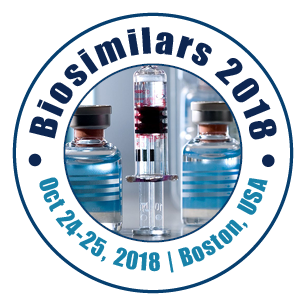
Karlheinz Landauer
Quality Biotech Development & Cells GmbH, Switzerland
Title: How to start a Biosimilar development: A risk based approach
Biography
Biography: Karlheinz Landauer
Abstract
With the big success of biologicals and the experience in generics, the biosimilar development was born. In Europe, the first biosimilars were already approved in the 2006 and since then many more followed. Regulators, especially in Europe, developed new guidelines promising fast access and fewer investment costs for biosimilar development programs. With the approval of Celltrion’s Remsima the first monoclonal antibody reached the market and today many companies around the world are increasing the efforts to develop and market their own biosimilars. Often the companies, and here especially small molecule pharma companies, do not intend to market their products worldwide but are addressing their own regional markets where they are already well established. Entering the biosimilar development and finally, markets is a risky venture. There are many candidate originators which could be copied, and thus need to be analyzed form business opportunity perspective but also from a manufacturing/technology perspective. As already mentioned, the companies often quite well understand their markets, thus business analysis is performed in detail and thoroughly. However, the manufacturability of biosimilars, like the type of originator cell line, mode of fermentation, the stability of formulation, etc. are not analyzed and understood in detail and not appropriately taken into account. After the decision for a specific biosimilar, newcomers underestimate the needs for thorough originator characterization and process development needs and the effort for process characterizations prior entering phase I clinical trial. Not only one company failed based on amino acid aberrations of their product, could not copy post-translational modification or even fail in needed formulation stability and finally, but the program was also stopped. Most often companies, who are intending to enter the biosimilar world, do not have R&D nor production capacities, thus they need to start with CDMO for their development programs and at the same time invest resources in the planning and construction of production facilities. Another trend is to in-license already established and approved products and starts with fill/finish works in-house and working itself backward till finally own R&D and API production capabilities are established, based on the revenues from the in-licensed products. We are presenting an overall investment analysis tool for biosimilars, a quick method to see how much resources need to be invested when, and effects on the program if not done in a timely manner. After the main road was defined as a second tool, to select the best candidate molecule will be shown in detail based on 30 analyzed molecules and finally, our standard CDMO selection guide will be briefly discussed. Having done these first three steps, biosimilar development is still not an automatic success, but it will help to overcome many obstacles by being aware that biosimilar development programs are time-consuming, resource intensive and for sure no generics.

